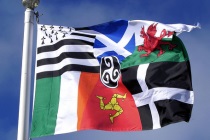Scottish island of Sanday in the Inner Hebrides to get its first road
The small Scottish Hebridean island of Sanday (Scottish Gaelic: Sandaigh) is to get its first road. When built it will replace a track that gets covered by water at high tide. The road will be a mile and a half long. Sanday is connected by a bridge to the larger neighbouring Isle of Canna. The Isle of Canna Community Development Trust is helping with a crowdfunding campaign to raise more than £31,400 to pay for the construction of the road. The National Trust for Scotland, which owns the two islands, has contributed funding.
Sanday's neighbour, Canna (Scottish Gaelic: Canaigh; Eilean Chanaigh), is the westernmost of the Small Isles archipelago, in the Scottish Inner Hebrides (Na h-Eileanan a-staigh). The island of Canna is 4.3 miles (6.9 km) long and 1 mile (1.6 km) wide. The skerries of Hyskeir and Humla lie 6.2 miles (10.0 km) south west of the island (a skerry is a small rocky island). Both Canna and Sanday were left to the National Trust for Scotland (Scottish Gaelic: Urras Nàiseanta na h-Alba) by their previous owner, the late Dr John Lorne Campbell and his wife Margaret Fay Shaw. Both were Gaelic scholars and collectors. Dr John Lorne Campbell and Margaret Fay Shaw dedicated their lives to capturing and preserving Hebridean culture and traditions. An enduring legacy is Canna House which is a nationally important archive of Gaelic culture and language, found in recordings, the written word, photography and a unique collection of butterflies and moths. The house is also in the care of the National Trust for Scotland, but currently closed to visitors due to extensive renovation and interpretation work.
Canna has a rich history having been inhabited since 5000 BC. Evidence of human activity that stretches from pre-history, into early Christian and Norse periods, and to the times of the Jacobite rebellions and the dark days of the population clearances in the 18th and 19th centuries. Pottery sherds found on the island date to the Neolithic era. There are a number of ancient and mysterious structures on Canna, such as the strange cellars dug into the ground. Then there is the standing stone is at Keill. Known as the punishment stone because legend has it that those who had committed a bad deed had their thumb jammed into a hole in the stone. Bronze Age remains are found on Canna, which include ancient field walls and fragments of huts circles. In the Iron Age Dun Channa hillfort was built.
In the 6th century the island was thought to have been associated with the the Irish missionary Columba when he first sailed to Iona. At Keill two large richly decorated Celtic crosses date from the 8th to 9th centuries and indicate the presence of a monastery. Canna was also part of the Kingdom of the Isles following the Viking raids of the 9th century and with other Hebridean islands was a Norwegian crown dependency of Suðreyjar (the Southern Isles). Viking involvement on Canna is evident from place names. A number of kerb-stone placements on the island are thought to indicate Viking ship burials. The largest on the north coast is known in Gaelic as Uaigh Righ Lochlainn which means "The grave of the King of Norway".
All of this history, along with the natural beauty and wildlife of the islands of Canna and Sanday make them popular places to visit and this is encouraged to help with economic regeneration. The new road will start at Canna bridge using locally sourced materials in its construction. Alongside the road the plan is to create a trail to link sites of interest on Sanday together. A large natural harbour is formed between Canna and Sanday which is sheltered and a popular stopping place for yachts. The pier on Canna is used by the Caledonian MacBrayne ferry, MV Lochnevis, which links Canna, and the neighbouring Small Isles of Rùm, Eigg and Muck, to the mainland port of Mallaig in Lochaber, on the west coast of the Highlands of Scotland.







